Arrangement
WARNING: Do not cite this page as a reference. This page is on this wiki to make the content "searchable" and easier to find. If you find the information you seek here, go to the original sources as linked below to verify the information and use them for your documentation.
Glossary of Terms:[edit | edit source]
The placement of charges in a group relative to the other charges in the group. For example, the arrangement three roundels two and one is different than the arrangement three roundels in fess. Arrangement is sometimes confused with location, and sometimes with orientation. See also Location, Orientation.
http://heraldry.sca.org/coagloss.html
Illustrations:[edit | edit source]
Period:[edit | edit source]
Animals inverted:[edit | edit source]
BSB392d Suddeutchland, 16th cent. Misc. Iberian inverted animals Above collected by Gunnvor silfrahar
Un-like animals combatant:[edit | edit source]
225x396px|BSB291 Insignia Anglica, 16th cent. English
Three charges with central un-like charge:[edit | edit source]
| File:BSB291 f43r Gonson.jpg | File:BSB291 f45r Eng16thC Lampon.JPG | |
| BSB291 f43r, Gonson, Insignia Anglica, Engl 16th c. | BSB291 f45r, Lampon, Insignia Anglica, Engl 16th c. |
In annulo, in cross:[edit | edit source]
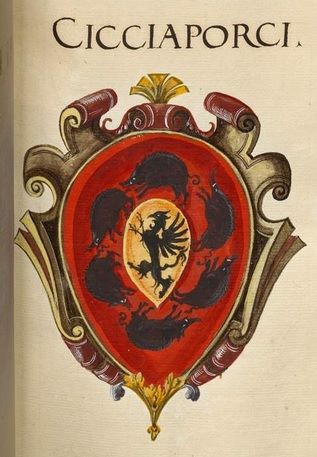 |
[[1]] | |
| BSB277 Insignia Florentinorum, Ciccipaporci canting arms, 16th cent. Italian | Siebmacher? |
A Heraldic Primer:[edit | edit source]
Arrangements - http://heraldry.sca.org/primer/arrangements.html (defunct)
Arrangement refers to the placement of charges relative to other charges in a single grouping. If you have a group of three charges (billets, say) there are many standard ways in which they can be arranged:
| Sable, in fess three billets argent. | 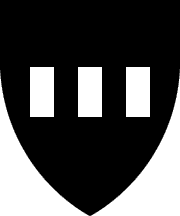
|
| Sable, three billets in pale argent. | 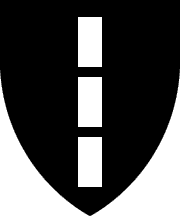
|
| Sable, three billets, two and one, argent. | 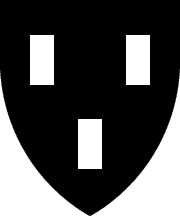
|
| Sable, three billets, one and two, argent. | 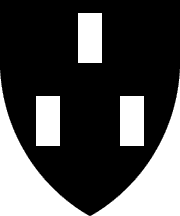
|
| Sable, in bend three billets palewise argent. | 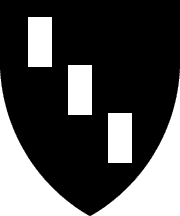
|
| Sable, three billets palewise in bend sinister argent. | 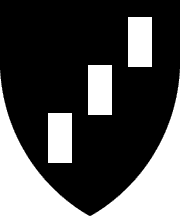
|
Note that the arrangement can appear in different positions in the blazon. Sometimes it appears before the number; sometimes it appears after the type. Both positions are legal for phrases that begin with the word "in". Phases consisting of lists of numbers should only appear afterthe type.
Note that it was necessary to specify the orientation of the billets when they were arranged "in bend" and "in bend sinister". This is because:
- charges arranged "in bend" are oriented "bendwise" by default
- charges arranged "in bend sinister" are oriented "bendwise sinister" by default
In many circumstances, there is a default arrangement. For instance, a group of three charges on the field are "two and one" if no other arrangement is specified.
SENA Appendix K: Standard Arrangements for Charge Groups of Different Number[edit | edit source]
http://heraldry.sca.org/sena.html#AppendixK
updated 3/2021
This appendix is a tool to determine if two charge groups of different sizes with different arrangements have comparable arrangements. First, identify the number of charges in each group and their arrangement. If the arrangement of either group is not listed below, then they are not in a standard arrangement and no DC can generally be given for arrangement between the two designs.
Pairs of charges in saltire and sheaves of charges are special cases for determining number. When there are multiple sets of charges each set counts as one charge for purposes of determining standard arrangement. So, for example, three pairs of axes in saltire and three sheaves of arrows both count as three charges for standard arrangement. New per 3/2021 Cover Letter
Next, check to see if the arrangement of the first group is also listed for the number of charges in the second group. Also check to see if the arrangement of the second group is also listed for the number of charges in the first group. If the answer is yes for both, then the arrangements are comparable and there is a DC between them for change to arrangement. If the answer is no to either one (or to both), the change to arrangement is forced and there is no DC between them.
List of Standard Arrangements by Number of Charges in a Group:
- For groups with one charge: in chief, in canton, in sinister chief, central, in base
- For groups with two charges: in pale, in fess (whether respectant, facing the same way, or addorsed), in (fess in) chief, in bend, in bend sinister, crossed in saltire
- For groups with three charges: two and one, one and two, in pale, in fess, in (fess in) chief, in bend, in bend sinister, in annulo
- For groups with four or more charges: in cross, in saltire, in pale, in fess, in (fess in) chief, in bend, in bend sinister, semy, in annulo, an orle of charge
Precedents:[edit | edit source]
Precedents of the SCA College of Arms - http://heraldry.sca.org/laurel/precedents.html
Morsulus Heralds Website - http://www.morsulus.org/ (to search the LoARs and Precedents)
Use the above links to be sure any precedents listed below haven't been superseded by newer precedents.
Definition/Registerability:[edit | edit source]
July 2021 - Unity of Arrangement further clarified[edit | edit source]
Bergdís Berbeinn. Device. Per pale Or and vert, an oak tree eradicated vert and three breasts two and one argent, on a point pointed gules a badger's head cabossed argent. This design presents no issue with SENA A3D2c, which requires all charges within a charge group to be in either identical postures/orientations or an arrangement that includes posture/orientation. Quoting and reaffirming the January 2014 Cover Letter, "From Wreath: SENA A3D2c and Arrangements, One More Time", which discusses the requirement of comparability when considering unity (emphasis added):
An arrangement of charges within a group that is blazonable is registerable, as long as it does not otherwise violate the unity of posture and orientation rule by having different postures/orientations amongst the group. In short, when you have comparable postures/orientations amongst the charges in a group, they should be in the same posture/orientation. For example, three swords in pall and an arrow fesswise has comparable charges in different orientations and would therefore be a violation of A3D2c, but four mullets in chevron and a rose would not. The latter may be poor style, but at this point we are not inclined to further restrict charge group arrangement upon the field.
The principle of comparability was also discussed in "From Wreath: Unity of Orientation and Posture", on the July 2019 Cover Letter, which includes "As another example, a stag's attire is usually found straight (and thus a long, orientable charge) but is also found in annulo in period. However, a sword (a long, orientable charge) cannot be in annulo. If a stag's attire and a sword are in the same charge group, they must either be in comparable orientations, or the attire must be in annulo (effectively rendering it a compact, non-orientable charge and thus in a different category)."
Since the tree and breasts are not comparable, there are no issues with either unity of posture or orientation, and so the question of a unified arrangement does not arise.
https://heraldry.sca.org/loar/2021/07/21-07lar.html#30
January 2014 CL SENA A3D2c and Arrangements, One More Time[edit | edit source]
From Wreath: A few submissions this month had commenters discussing whether or not they violated "unity of arrangement." SENA A3D2c, Unity of Posture and Orientation, does not actually govern arrangement on the field. Specifically, it states in full:
The charges within a charge group should be in either identical postures/orientations or an arrangement that includes posture/orientation (in cross, combatant, or in pall points outward, for example). A charge group in which postures for different charges must be blazoned individually will not be allowed without period examples of that combination of postures. Arrangements of charges which cannot be blazoned will not be allowed. Some standard arrangements for period charge groups are discussed in Appendix K.
Precedent set on the May 2012 Cover Letter stated that "if the charges in a single charge group do not have comparable postures, they are not in violation of the "identical postures/orientations" part of the rule. The charge group as a whole must still be in a standard arrangement." That last sentence has been interpreted, along with the reference to Appendix K, to mean that only arrangements found in Appendix K are valid. However, we also ruled on the November 2012 Cover Letter that Appendix K is not meant to be all inclusive, and that "charges in a single group split in two by a field division or a central ordinary that are placed to reasonably fill the space available to them and that are similar to period patterns will be considered to be in a default arrangement, and they do not require their exact positioning to be blazoned."
We feel some clarity is in order. An arrangement of charges within a group that is blazonable is registerable, as long as it does not otherwise violate the unity of posture and orientation rule by having different postures/orientations amongst the group. In short, when you have comparable postures/orientations amongst the charges in a group, they should be in the same posture/orientation. For example, three swords in pall and an arrow fesswise has comparable charges in different orientations and would therefore be a violation of A3D2c, but four mullets in chevron and a rose would not. The latter may be poor style, but at this point we are not inclined to further restrict charge group arrangement upon the field.
https://heraldry.sca.org/loar/2014/01/14-01cl.html#7
June 2013 Cover Letter - Handling Pairs and Sheaves in Arrangements:[edit | edit source]
Commenters were asked to discuss how best to handle sheaves or pairs of charges combined with other charges in the same charge group. SENA A3D2c requires charges in a group to be in identical postures/orientations or in an arrangement that includes posture/orientation. It also states, "A charge group in which postures for different charges must be blazoned individually will not be allowed without period examples of that combination of postures." Precedent has said, "The charges here do not have comparable postures or orientations, but they also are not in a unified standard arrangement, as the two chisels in saltire must be blazoned separately from the crab in order to adequately describe their positioning. [William the Myllwright, R-Atenveldt, Dec 2012 LoAR]" However, does this precedent follow period practice? Commenters dug through many different armorials across all of Europe to find out.
Most cases of pairs of charges have a single pair of identical charges in saltire as the sole primary charge group. There were also examples of multiple pairs of identical charges in the same charge group. More uncommon were examples of non-identical charges in saltire, most typically a key or a sword and another charge, as they tended to be ecclesiastically related. There were no examples found of multiple pairs of non-identical charges in the same charge group.
For an example of multiple pairs of charges in the same design, the arms of the Worshipful Company of Fishmongers, granted in 1512, are Azure, three dolphins naiant embowed in pale argent finned toothed and crowned Or between two pairs of stockfish in saltire argent over the mouth of each fish a crown Or, on a chief gules three pairs of keys of St Peter in saltire.
Most cases of a sheaf of charges were sheaves of arrows. There were other examples of three identical charges arranged in a sheaf, and a few example of two charges in saltire surmounted by a different charge palewise, again typically ecclesiastical in nature, such as two keys in saltire surmounted by a crozier. Again, the vast majority of examples were of a single sheaf as the sole primary charge group. For an example of multiple sheaves of charges in the same design, the arms of Nicholas Robinson, Bishop of Bangor from 1566-1585, are given by Parker as Azure, a chevron between three sheaves of arrows argent.
It is tempting to consider a sheaf of charges as a single charge, but it is not: it has long been considered as heraldic shorthand for two charges in saltire surmounted by a third charge palewise, and the charges that make up the sheaf are counted individually for purposes of differencing by number. Likewise, while it is tempting to consider a pair of charges in saltire as a single charge, it is not; it is clearly two separate charges arranged in saltire. However, SENA A3D2c does not concern counting charges, merely their placement upon the field in a period arrangement.
Given the period examples, we are overturning past precedent forbidding the combination of a charge and two other charges in saltire, or other similar combinations. We will henceforth treat a pair of charges in saltire and a sheaf of charges as a single unit only for purposes of arrangement under SENA A3D2c. As always, the entire charge group must be in a blazonable period arrangement, such as two and one, in fess, in cross, etc. http://heraldry.sca.org/loar/2013/06/13-06cl.html
November 2012 Cover Letter - Charge Groups Doing the Splits[edit | edit source]
Now that we've covered the posture/orientation of individual charges in a group, we turn to their placement upon the field. SENA A3D2c only peripherally covers this topic when it references SENA Appendix K, which lists some standard arrangements. However, Appendix K is primarily intended for determining if a DC for change of arrangement exists when comparing two groups from two pieces of armory. It does not list all of the possible standard period arrangements for charges in a single group on the field.
When considering a group of charges split over a divided field or separated by a central ordinary, period armory typically draws and places such charges in whatever way allows them to best fit and take up the most space possible. Examples:
- BSB Cod.icon.291, f. 13r: _Argent, on a bend sable between three wolf's heads gules three birds argent_. The two wolf heads in the upper portion of the field are in fess.
- BSB Cod.icon.291, f. 24r: _Gules, a bend between six cross crosslets fitchy argent_. The three crosses in the upper portion of the field are placed two-and-one, and the three crosses in the lower portion of the field are in bend.
- Beinecke MS 648, f. 38v: _Or, a bend between six martlets gules, a label azure_. The three martlets in the upper portion of the field are placed "in right triangle" to follow the edge of the shield, with one firmly in the corner, one to the left, and one below. The three martlets in the lower portion of the field are in bend.
- The Luttrell Psalter, f. 202v, has an illumination showing six different depictions of the same arms. Sir Geoffrey Luttrell's arms were "Azure, a bend between six martlets argent". His arms are shown on a heater shield, like our device form escutcheon, on his ailettes, a square shape like our badge form, a triangular pennant, his saddle, his horse barding, his crest, his surcoat, and on two dresses. The martlets on either side of the bend are arranged in all combinations of two-and-one, "in right triangle", in bend, in pale, and "in swoop" where the birds are mostly in bend with the centermost moved out of line a bit. Therefore, charges in a single group split in two by a field division or a central ordinary that are placed to reasonably fill the space available to them and that are similar to period patterns will be considered to be in a default arrangement, and they do not require their exact positioning to be blazoned. This is similar to our policy of allowing and not distinguishing various period-style arrangements of strewn charges, and in general not blazoning period-style artistic variations. Note that this applies only to arrangement, not to posture or orientation.
http://heraldry.sca.org/loar/2012/11/12-11cl.html
February 2008 Cover Letter - On Sheaves:[edit | edit source]
A submission this month (Marguerite la fileresse de saie, Artemisia) raised the question whether a sheaf should be considered a single charge or three charges. Recent precedent has been that a sheaf of charges should be considered a single charge. While there may be earlier precedents, the easiest precedent to find is from June 2001: "A sheaf is considered a single charge, therefore there is only a single CD for changing the type of the secondary charges." This was upheld in July 2003 (v. Bjorn Krom Hakenberg, Atenveldt). Consider two hypothetical cases. First, comparing Argent, a fess between two books vert to Argent, a fess between two sheaves of arrows vert. Second, comparing Argent, a fess between two books vert to Argent, a fess between two pairs of arrows in saltire vert. Given the 2001 precedent, the first case would be a conflict with a single CD for changing the type of secondary charges, but the second would be clear with a CD for changing the type and number of secondary charges. This treatment of charges seems inconsistent and nearly impossible to explain to submitters. In June 1990 Laurel ruled: > The usage "a sheaf" for "two [charges] in saltire surmounted by a third palewise" is a space-saving Society convention: it does not necessarily mean that the [charges] must be counted for difference as a single unit any more than a sword and a quill in saltire would be considered a single item. (17 Jun 90, p. 13) This view of a sheaf of charges is more consistent with how we treat other arrangements of charges. The 2001 precedent defining a sheaf of charges as a single charge is hereby overturned: a sheaf of charges shall be considered as three charges in a specific arrangement, not a single charge. http://heraldry.sca.org/loar/2008/02/08-02cl.html
September 2003 LoAR - in orle:[edit | edit source]
In a charge group blazoned as An orle of [charges] in orle, the charges are arranged in orle and the postures of the charges tilt so that they follow each other. Thus, an orle of fish naiant would all be in the default naiant (fesswise) posture, but an orle of fish naiant in orle swim head to tail." September 2003 LoAR
September 2003 LoAR - on a chapé field:[edit | edit source]
[Argent chapé azure, three goblets two and one gules] It is not clear what the default arrangement for three charges on a chapé field should be. The usual default on a plain field (two and one) doesn't fit well on a chapé field, and thus seems an unlikely default for that field. We have thus blazoned the arrangement explicitly. [Waldemar Stanislaw of White Mountain, 09/2003, A-Trimaris] http://heraldry.sca.org/precedents/francois/wreath.html#DEFAULT
August 1993 LoAR - in annulo:[edit | edit source]
"the in annulo placement visually dominates, and thus subsumes, any specification of direction. Widdershins' vs. deasil is simply an artistic nuance of in annulo, and need not be blazoned." [Clarification note: Thus there is no difference between "three X in annulo" and "three X contourny in annulo".] [http//www.sca.org/heraldry/loar/1993/08/lar.html August 1993 LoAR]
February 1985 LoAR - six charges:[edit | edit source]
"The default arrangement for six charges is three, two and one. [BoE, 3 Feb 85, p.8]" - http://heraldry.sca.org/precedents/baldwin.html
Registerability:[edit | edit source]
(Restricted, Reserved, SFPP, OOP)
August 2019 CL - Charges In Annulo[edit | edit source]
On the January 2019 LoAR, I asked for commentary on what form of charges in annulo not in their default orientation, if any, should be allowed in SCA armory. This discussion was a culmination of two years struggling to give clear and unambiguous guidance to submitters who wanted animate charges chasing one another in a circle. This is a very popular motif with submitters, despite it being ruled a step from period practice. I recognize the difficulty in finding the balance between authenticity and aesthetic, and am sensitive to the need to appease submitters.
However, successive attempts to minimize the number of animate charges one can recognizably put in annulo has led to charges whose postures are warped out of a recognizable heraldic posture; artists frequently focus so much on making a given charge appear to be an arc of an annular shape that they've lost sight of the identity of the charge as a stand-alone creature with a recognizable posture. This is in no doubt due to the rulings that I and my predecessors have made in attempts to clarify the rules and make them easier for submitters to understand. Unfortunately, the opposite has occurred.
Current precedent (most recently upheld in December 2018) states that charge groups of five or fewer charges must form an annular shape through their orientations and postures, or risk being returned. The example from December 2017 states that "Three wolves rampant, heads to center, cannot be in annulo, because their arrangement and orientation do not suggest an annulet. However, three wolves courant can be in annulo, provided their bodies curve and conform to the shape of an annulet." The December 2018 return, which featured three bears in a triangular shape, noted that "the bears are passant, with straight backs that flex inwards, and with lowered paws that rest on a straight plane. No circle is formed or even implied by their placement, so they cannot be considered "in annulo" per the above ruling."
So what do we mean by "in annulo?"
For a single charge, "in annulo" can be a posture or orientation, such as the attested postures of dragons in annulo, or the attested orientation of a stag's attire in annulo. Use of "in annulo" as a posture is limited to those charges who are attested to have used it in period, while the orientation is more flexible.
For multiple charges, "in annulo" is an attested (though rare) arrangement similar to and almost indistinguishable from "in orle," where the placement of the charges on the field forms a roughly circular shape. This arrangement is separate from their orientation, and so the shape must be formed with enough charges to establish the existence of a circle. This distinction between arrangement and orientation has been the major source of confusion, so it's important to distinguish how many charges may be arranged "in annulo."
Two charges cannot be arranged "in annulo" as their relative placement is more accurately described as "in pale," "in bend," "in fess," etc. Likewise, three charges cannot be arranged "in annulo" as their placement can be more accurately described as "one and two" or the default for three charges, "two and one." And four charges cannot be arranged "in annulo" when "in cross" or "in saltire" are more accurate descriptions.
Therefore, a charge group must have a minimum of five charges, with a preference for six or more, in order to be arranged "in annulo." Four or fewer charges will no longer be blazoned "in annulo" for submissions appearing on external letters of intent after February 1, 2020.
Separate from the arrangement of charges "in annulo" is the common but largely unattested orientation with the charge's primary axis either parallel or perpendicular to the circle the charges form. This rotational symmetry is almost entirely absent from period armorial design; when it does appear, it's seen almost exclusively with inanimate charges, e.g. a lunel (an Iberian motif formed of four or five crescents conjoined, horns to center).
Arrangements are usually orientation-neutral (in fess, in pale, in bend), but there are examples of arrangements of two long charges that include orientation by default. The classic example is "in saltire." For five charges in the charge group, the items in saltire are arranged two, one, and two, with no orientation implied. However, with two long charges in the charge group, the orientation is supplied; one is in bend sinister, with the other surmounting it in bend. "In chevron" or "in pall" likewise can be orientation-neutral for several charges, but become orientation-specific for two or three long charges, respectively.
For inanimate charges, charges "in annulo" are orientation-neutral; the five crescents above are blazoned first by arrangement (in annulo) and then by orientation (horns to center).
The problem with this model arises when submitters attempt to use the "in annulo" motif to circumvent the prohibition of animate charges inverted; that is, using "in annulo" as an orientation. Animate charges have postures, which have inherent orientations. In the October 2018 return of the joint badge for Mir Netronin and Mikael MacLeod, it was ruled, "The posture of a quadruped relies heavily on the context of the orientation of its spine. Known period examples of quadrupeds who have nonstandard orientations are almost always on bends, and always with their head oriented towards chief. Absent documentation, quadrupeds in nonstandard orientations relative to their postures will be returned."
There being no evidence of animate charges oriented in annulo, the continued allowance of this step from period practice relies on whether it causes identifiability issues. As noted in the May 2018 Cover Letter, steps from period practice that fall under SENA A2B4d "are tolerated because they're remarkably popular and function effectively as armorial elements without causing undue confusion. However, inclusion or exclusion of these charges in past rulings was far more subjective, and such elements could cease being registerable if they became problematic."
That said, moving forward we will allow animate charges oriented in annulo as a step from period practice only if the following criteria are met:
- There are a minimum of five charges in the charge group
- The charges form the appearance of an annulet, either solid or broken
- Each charge is independently recognizable in both type and posture
Points 2 and 3 above are important to consider together. As noted at the start of this article, charges in past submissions have been warped to form an annular shape at the expense of individual identification. This has been and will continue to be grounds for return.
Animate charges which are attested in period to be in annulo singly, such as serpents and dragons, will continue to be registerable without a step from period practice.
Other attempts to circumvent the prohibition on inverted animate charges, such as in cross four wolves statant, bellies to center, will require evidence of those charges appearing in that posture and orientation in period armory. The classic example is three rabbits courant conjoined at the ears found in the arms of Harewelle, Hasloch, and other families in period.
The new ruling will apply to all submissions appearing on external letters of intent published after February 1, 2020. Existing precedent will be applied to submissions appearing in letters published before that date.
https://heraldry.sca.org/loar/2019/08/19-08cl.html#3
January 2014 Cover Letter - Phases of the Moon:[edit | edit source]
The "phases of the moon" motif of a roundel between an increscent and a decrescent has long been considered a step from period practice. As early as August 1989 it was declared "not really period style," but did not seem to be considered a step from period practice until September 1998. We know that the motif of an X between two Ys is a fairly common one in later period English armory. Non Scripta found evidence of a rose between two lions combattant and a mullet between two lions combattant, and Elmet added a fleur-de-lys between two rabbits passant respectant, all in English armory. Orle actually found a roundel between a decrescent and an increscent in Italian armory. We have never considered an X between two Ys respectant to be considered a step from period practice with any other combination of charges, only with a roundel and crescents, which is not consistent. Therefore, we are overturning past precedent. This motif is no longer considered a step from period practice. http://heraldry.sca.org/loar/2014/01/14-01cl.html
December 2012 Cover Letter - In Annulo and You[edit | edit source]
A submission this month raised the issue of whether or not multiple charges _in annulo_, where the charges are arranged and turned in a circle so that each charge has a different orientation, is found in period armory. Evidence provided suggests that in fact it is not a period motif at all. Multiple charges arranged _in annulo_ or _in orle_ are typically only found _palewise_ in period armory.
However, that design motif has a long history in Society heraldry, and so we are not inclined to banish it at this time. Therefore, the motif of multiple charges _in annulo_ or _in orle_, where the charges are not in their default orientation is henceforth considered a step from period practice. http://heraldry.sca.org/loar/2012/12/12-12cl.html
Conflict:[edit | edit source]
August 1993 LoAR - in annulo:[edit | edit source]
"the in annulo placement visually dominates, and thus subsumes, any specification of direction. Widdershins vs. deasil is simply an artistic nuance of in annulo, and need not be blazoned." [Clarification note: Thus there is no difference between "three X in annulo" and "three X contourny in annulo".] August 1993 LoAR
Identifiability:[edit | edit source]
Collected Precedents:[edit | edit source]
- 2nd Tenure of Elisabeth de Rossignol (April 2011 - 2011) - ARRANGEMENT
- 1st Tenure of Elisabeth de Rossignol (May 2005 - July 2008) - ARRANGEMENT, ARRANGEMENT - Conjoined, ARRANGEMENT - Forced Move
- The 2nd Tenure of François la Flamme (October 2004 - May 2005) - ARRANGEMENT
- The Tenure of Shauna of Carrick Point (May 2004 - August 2004) -Arrangement, Conjoined, Forced Move, Three Charges
- The Tenure of François la Flamme (August 2001 - April 2004) - ARRANGEMENT, ARRANGEMENT -- Conjoined, ARRANGEMENT -- Forced Move
- The Tenure of Elsbeth Anne Roth (June 1999 - July 2001) - ARRANGEMENT
- The Tenure of Jaelle of Armida (June 1996 - June 1999) - na
- The 2nd Tenure of Da'ud ibn Auda (November 1993 - June 1996) - Arrangement
- The Tenure of Bruce Draconarius of Mistholme (June 1992 - October 1993) - ARRANGEMENT
- The 1st Tenure of Da'ud ibn Auda (June 1990 - June 1992) - ARRANGEMENT (first part), ARRANGEMENT (second part)
- The Tenure of Alisoun MacCoul of Elphane (September 1986 - June 1990) - na
- The Tenure of Baldwin of Erebor (August 1984 - August 1986) - Single HTML Document
- The Tenure of Wilhelm von Schlüssel (August 1979 - August 1984) - ANNULO
- The Tenure of Karina of the Far West (December 1975 - June 1979) - na
- The Early Days (June 1971 - June 1975) - ANNULO]
In the Ordinary:[edit | edit source]
- Arrangement - Beast - see Arrangement - Creature]
- Arrangement - Creature - Addorsed]
- Arrangement - Creature - Combattant - Argent]
- Arrangement - Creature - Combattant - Azure]
- Arrangement - Creature - Combattant - Fur]
- Arrangement - Creature - Combattant - Gules]
- Arrangement - Creature - Combattant - Multicolor]
- Arrangement - Creature - Combattant - Or]
- Arrangement - Creature - Combattant - Purpure]
- Arrangement - Creature - Combattant - Sable]
- Arrangement - Creature - Combattant - Vert]
- Arrangement - Creature - Respectant]
- Arrangement - Head - Addorsed]
- Arrangement - Head - Respectant]
- Arrangement - In annulo - 4 or fewer]
- Arrangement - In annulo - 5 or more]
- Arrangement - In arch]
- Arrangement - In bend - 2]
- Arrangement - In bend - 3]
- Arrangement - In bend - 4 or more]
- Arrangement - In bend sinister]
- Arrangement - In bordure - see [Arrangement - In orle]
- Arrangement - In chevron]
- Arrangement - In chevron inverted] - see also Arrangement - In pile]
- Arrangement - In compass star - see [Arrangement - In annulo]
- Arrangement - In cross - Argent]
- Arrangement - In cross - Azure]
- Arrangement - In cross - Fur]
- Arrangement - In cross - Gules]
- Arrangement - In cross - Multicolor]
- Arrangement - In cross - Or]
- Arrangement - In cross - Purpure]
- Arrangement - In cross - Sable]
- Arrangement - In cross - Vert]
- Arrangement - In demi annulo - see Arrangement - In arch]
- Arrangement - In estoile]
- Arrangement - In fess - 2]
- Arrangement - In fess - 3]
- Arrangement - In fess - 4 or more]
- Arrangement - In mascle]
- Arrangement - In mullet - see [Arrangement - In annulo] and Arrangement - In estoile]
- Arrangement - In orle - Argent]
- Arrangement - In orle - Azure]
- Arrangement - In orle - Fur]
- Arrangement - In orle - Gules]
- Arrangement - In orle - Multicolor]
- Arrangement - In orle - Or]
- Arrangement - In orle - Purpure]
- Arrangement - In orle - Sable]
- Arrangement - In orle - Vert]
- Arrangement - In pall] #arrangementinpallinverted
- Arrangement - In pall inverted] #arrangementinpile
- Arrangement - In pile] - see also Arrangement - In chevron inverted]
- Arrangement - In rainbow - see [Arrangement - In arch]
- Arrangement - In saltire - 2 - Primary - Argent]
- Arrangement - In saltire - 2 - Primary - Azure]
- Arrangement - In saltire - 2 - Primary - Fur]
- Arrangement - In saltire - 2 - Primary - Gules]
- Arrangement - In saltire - 2 - Primary - Multicolor]
- Arrangement - In saltire - 2 - Primary - Or]
- Arrangement - In saltire - 2 - Primary - Purpure]
- Arrangement - In saltire - 2 - Primary - Sable]
- Arrangement - In saltire - 2 - Primary - Vert]
- Arrangement - In saltire - 2 - Secondary - Argent]
- Arrangement - In saltire - 2 - Secondary - Azure]
- Arrangement - In saltire - 2 - Secondary - Fur]
- Arrangement - In saltire - 2 - Secondary - Gules]
- Arrangement - In saltire - 2 - Secondary - Multicolor]
- Arrangement - In saltire - 2 - Secondary - Or]
- Arrangement - In saltire - 2 - Secondary - Purpure]
- Arrangement - In saltire - 2 - Secondary - Sable]
- Arrangement - In saltire - 2 - Secondary - Vert]
- Arrangement - In saltire - 2 - Tertiary]
- Arrangement - In saltire - 4 or more]
- Arrangement - In trefoil - see Arrangement - In pall inverted]
- Arrangement - In tressure - see Arrangement - In orle]
- Arrangement - In triangle - see Triangle]
- Arrangement - In triquetra]
- Arrangement - In triskele - see Triskelion]
- Arrangement - In triskelion - see Triskelion]
- Arrangement - Monster - see Arrangement - Creature]